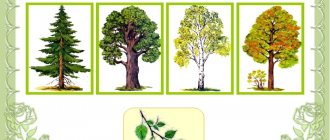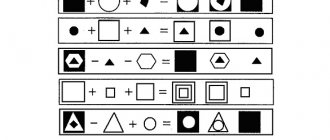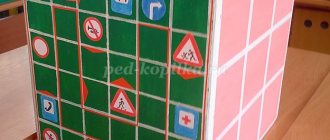One of the modern trends in preschool pedagogy is financial education of children. After all, kids, one way or another, find themselves involved in the economic life of the family: they go to stores with their parents, encounter advertising, and understand that their parents earn money to buy goods and services. The task of a kindergarten teacher is to present basic financial concepts in the most accessible and fun way possible. For this purpose, you can create a wonderful interactive guide with your own hands - a lapbook.
- 2 Information content of the laptop
2.1 A selection of riddles on an economic topic - 2.2 A selection of proverbs about work
For what age is a financial literacy lapbook relevant?
Children become acquainted with the world of economics in kindergarten and in senior preschool age; it is at this time that the teacher should start developing a laptop on this topic. In classes on understanding the world around us, children receive basic concepts about family needs, income and expenses, goods and services, and learn what money and advertising are.
Meanwhile, much earlier, the financial side of life is touched upon in children's role-playing games: after all, even in the younger group, all children play in a store, cafe, hairdresser, that is, they try on the roles of a seller and a buyer.
Even in the younger group, kids play at the store (try on the roles of a seller and a buyer), but a laptop on a financial topic will be relevant in older preschool age
The teacher should definitely involve his students in the process of creating a lapbook: the children can cut out cards, envelopes (using simple templates), and glue elements to the manual. Parents can also help, for example, by bringing coins from the times of the USSR or other countries, if there are any at home.
Older preschoolers may well help the teacher create a lapbook
Progress of the game.
Show the children pictures of people in different professions. Children, guided by the drawings, name the professions of their parents, their loved ones, and all those they meet. Having received pictures from the cash register with images of fairy-tale characters, he asks to guess their professions. Give the girls drawings depicting fairy-tale characters, and the boys with images of people of different professions. At the signal of the bell, girls and boys begin to look for their pair and sit down at the tables in twos, and then take turns proving the correctness of their choice. You can invite children to show the profession of their hero with the help of movements, imitations and other figurative actions. Organize a gradual transition to role-playing games on this topic. You can also have conversations about how the hero feels about his work, who produces goods and who provides services (if children are familiar with these concepts)
.
14. "What's more important?"
Purpose: to give an idea of limited resources with unlimited needs.
Objectives: strengthen the ability to navigate the concepts of “luxury goods”
and
“vital items”
; learn to differentiate objects according to their degree of significance, making logical conclusions.
How interesting it is to design a laptop on an economic topic
First of all, you need to come up with a bright name for your lapbook (you don’t just need to write “Economics” or “Finance”). The options may be as follows:
- "Young Economists";
- “We play economics”;
- “The first lessons of the Queen of Economics”;
- "Rublika Game Library";
- "School of the Gnome Economy";
- "Economgrad".
Naturally, the title is placed on the cover in a large, beautiful font. The cover itself can be made hinged in the form of a solid picture.
Hinged covers always look interesting
It is advisable to paste on the cover a picture of a character who personifies the world of economics for children. For example, it could be Dwarf Economy or Queen Economy.
It’s good to come up with a character who personifies the world of Economics for children and put him on the cover of a lapbook
You can show your imagination when choosing the general shape of the lapbook. For example, make it in the form of a suitcase (case) with a handle. Another non-standard option is in the form of nesting dolls on which information is placed.
Unexpected, but interesting - a laptop in the shape of nesting dolls
Likewise, the pockets of the manual can be reminiscent of its theme - they can represent wallets, baskets (like in a supermarket).
You can make original pockets according to the theme of the laptop (wallets, shopping cart)
You should use as many interesting design elements as possible. For example, these are baby books that children love to look at.
Children love to look at notebooks and baby books.
A wonderful idea is an envelope in the shape of a flower “Learning to save.” Its petals tell you how you can save your finances.
In the center of such a flower envelope you can depict a piggy bank
You can also place three-dimensional elements inside the lapbook - a mock-up of a Sberbank ATM or a store cash register.
A very original idea - to place a Russian mini-ATM inside the laptop
It is advisable to include in the manual an element in the form of a ribbon, for example, made from paper coins. This always causes additional interest in children.
The kids love unfolding and folding ribbon-shaped items
Card index of games to develop the basics of financial literacy for children of senior preschool age
Stepanova O.N., Lomakina N.M. Card index of games to develop the foundations of financial literacy for children of senior preschool age // Sovushka. 2020. N1 (19). URL: https://kssovushka.ru/zhurnal/19/ (date of access: 10.10.2020).
Order No. 552019
Didactic game “Put the coins in order”
Goal: to develop children’s ability to correlate banknotes by value.
Objectives: to train children in the ability to navigate in banknotes and operate with them.
Material: coins (pictures) in denominations of 1 ruble, 2, 5, 10 rubles.
Progress of the game:
Children are asked to arrange the coins first in ascending order, then in descending order.
Didactic game "Exchange"
Goal: to develop children’s ability to distinguish coins, exchange and collect the same amount in different ways.
Objectives: to train children in the ability to navigate in banknotes, operate with them, consolidate the composition of a number from 2 smaller ones to 10.
Material: teaching aid : cards with a picture of a wallet with a designated number (2,3,4,5, 6,7,8,9,10), coins (pictures) in denominations of 1 ruble, 2, 5 rubles).
Progress of the game:
Children are asked to choose a wallet and make up the amount indicated on the wallet in different ways using coins.
Didactic game “ Buy Misha (Masha) a gift”
Goal: developing children's shopping skills.
Objectives: to train children in the ability to navigate in banknotes, operate with them, develop children’s ability to make the right choice and buy the desired goods, taking into account the gaming preferences of boys and girls, provided that they have a certain amount of money to purchase the purchase.
Material: cards with the image of a wallet with a designated number (6,7,8,9,10), coins (pictures) in denominations of 1 ruble, 2, 5 rubles in accordance with the amount indicated on the wallet, cards with images of shelves on which toys are placed , stationery, books with price tags, basket.
Progress of the game:
Children are invited to choose a gift from the goods offered in the store.
Didactic game “Let’s help Masha buy healthy products”
Goal: developing children's shopping skills.
Objectives: to train children in the ability to navigate banknotes, operate with them, and choose only healthy products for the amount indicated on the wallet.
Material: cards with the image of a wallet with a designated number (6,7,8,9,10), coins (pictures) in denominations of 1 ruble, 2, 5 rubles in accordance with the amount indicated on the wallet, cards with images of shelves on which various food products: milk, sour cream, vegetables, fruits, candies, juice, Coca-Cola, chocolate, etc., shopping basket.
Progress of the game:
Children are invited to purchase healthy products for the specified amount.
Didactic game “Help Mom buy groceries”
Goal: developing children's shopping skills.
Objectives: to train children in the ability to navigate banknotes, correlate banknotes by value, operate with them, correlate desires with financial capabilities, and cultivate frugality.
Material: cards with a picture of a wallet with a designated number (6,7,8,9,10), coins (pictures) in denominations of 1 ruble, 2, 5 rubles in accordance with the amount indicated on the wallet.
Task cards (pictures depicting necessary goods), model cards “Fund for Helping Homeless Animals”, “Piggy Bank”, “Family”.
Progress of the game : Children are invited to make purchases in accordance with the task card, use the remaining money from the purchase at their discretion: buy something for themselves, donate it to charity, return it to their mother or put it in a piggy bank.
Role-playing game " Supermarket "
Goal: to consolidate the purchase algorithm and buyer actions.
Tasks:
- continue to learn how to solve problem situations, give reasons for your answers, and activate your vocabulary.
- promote the development of attention, logical thinking, coherent speech; promote the formation of communicative relationships.
- promote the development of moral qualities, a correct attitude towards money and its wise use.
Material: inventory and equipment of the role-playing game “Supermarket”; a set of cards for the distribution of roles (with the image of a buyer - 4 pcs., cashier - 2 pcs., seller - 3), 5 cards depicting a set of products and goods, 4 bank cards, 4 wallets with a set of coins and bills.
Progress of the game:
Game roles: seller, buyer, cashier. Children are asked to choose a card and determine what role they will play in the game.
Game actions: Sellers go into the sales area, check the presence of price tags, and the order on the shelves. Cashiers are invited to enter the box office. Buyers are asked to select a card with a set of goods required for purchase and determine the payment method (cash or non-cash).
Buyers go to the store to make purchases, making purchases and correlating the amount of money with the price of the product and the amount of purchases purchased. They go to the checkout and pay for the goods.
The development of the game involves combining the plots with the role-playing game “Family”, “Cafe”.
Photo gallery: ready-made lapbook spreads on financial literacy
When folded, the laptop looks like a case with a handle.
All pockets of the laptop are presented in warm colors, with ribbon elements placed in the center
Unusual elements of a lapbook - a flower envelope and a money printing machine
A distinctive feature of the laptop is the coins in transparent pockets
The laptop contains a unique mini ATM and includes a real calculator
Didactic games for the formation of economic ideas of senior preschool age
Didactic games for the formation of economic ideas of senior preschool age
“Who does what?” (working people)
Expand children's knowledge about professions
and
work activities; to cultivate interest in new professions and respect for the work of adults.
Material.
Cards depicting a profession (salesman, cook, cashier, artist, banker) and labor action (weighs goods, prepares food, draws, talks, counts money, shows advertising samples,
etc.
)
Contents -
The child, taking a card, names the profession.
Finds the corresponding card with the image of labor actions and talks about them. Option.
Children select tools (pictures) that are necessary for the work of people in the professions depicted in the plot pictures.
“Name the professions” Purpose.
Teach the child to establish a relationship between the results of work activity and a person’s profession; develop an interest in people of different professions.
Material.
A chamomile flower, the petals of which conventionally depict the results of the work of people of different professions.
Contents -
The child, tearing off a chamomile petal, names a profession related to satisfying a specific need.
The game “Who is doing what?”
Goal: consolidating children’s knowledge about the profession, enriching children’s verbal dictionary, developing attention and dexterity.
We will never forget
What people can do.
Option 1.
When throwing or rolling a ball to a child, the teacher names a profession, and the child, returning the ball to the teacher, must name a verb denoting what the person in the named profession does.
Option 2
The teacher names the verb, and the child names the profession (sells - seller)
“Where was Petya?”
The goal of the game
. Teach children to describe the work of people, to guess from the description what the child is talking about.
Content-
The teacher tells the children that they will play a game that will make them remember everything they saw in their kindergarten: what rooms are there, who is in them, what is in each room, what they do in it. The teacher says: “Today we will play a game as if a new boy, Petya, has come to our kindergarten. Together with his teacher, he went to inspect the kindergarten. But where he went and what he saw there, Petya will tell. You will speak on behalf of Petya. Don't call the room a word. We must recognize her ourselves from your description.” Here are approximate descriptions given by the children: “Petya entered the room where there was a lot of clean linen on the shelves, Maria Petrovna was ironing it, the washing machine was humming (Laundry).” “Petya looked into the room where children were singing, dancing, and someone was playing the piano. The room was large and bright (Hall).” The teacher warns the children that they need to describe only what Petya could see in the kindergarten building. If a child talks about something that is not in the children's court, he is considered a loser.
"Who is bigger?"
Purpose of the game. Teach children to relate people’s actions to their profession, activate their vocabulary, and develop the ability to think quickly.
Before the game, the teacher conducts a short conversation, clarifying the children’s understanding of the words “profession” and “actions”: “Children, I work as a teacher in a kindergarten. This is my profession. Tolina’s mother treats the sick. Her profession is called "doctor". What do you think is the profession of Antonina Vasilievna, who cooks dinner for us? (Children answer: “Cook.”) Name what professions you know. (Children call: “Driver, teacher, shoemaker, pilot, etc.”) Each person, having his own profession, works and performs some actions. What does a cook do? (Children answer: “Cooks, bakes, fries, grinds meat, peels vegetables, etc.”) Now we will play with you the game “Who can name the most actions.” I will name a profession, and you will remember all the actions of a person in this profession.” The teacher says the word “doctor”. The children answer: “Examines patients, listens, treats, gives medicine, gives injections, operations.” “Tailor” - bastes, cuts, flogs, irons, tries on, sews, etc. The teacher names professions familiar to the children: janitor, nanny, laundress, driver, etc. Children remember what people in these professions do.
Whoever names the most actions is considered the winner.
“Who works, who plays” - Goal.
To consolidate children’s ideas
about
the difference between work and play activities (work - non-work).
Material.
A set of cards depicting work and game processes.
Each child has a set of paired cards (work - play activities). The child describes the images, names the processes (a boy cleans a shoe, a girl washes doll clothes, children dance, play, etc.), establishes differences (the presence of a result of labor or its absence)
Game “Who Produces What”
Purpose:
to emphasize that certain knowledge and skills are required to perform various jobs.
Rules:
connect with an arrow who produces what.
Material:
images of finished products, people of different professions; pencil. The cook is at the stove, the turner is at the machine. A gardener in the garden, an artist at an easel, a tailor at a sewing machine.
“What are the types of income?” (money and its purpose) Purpose.
Clarify children’s knowledge about basic and additional incomes; improve skills in independently determining types of income (main and non-main).
Material.
Cards depicting the main types of activities for which adults receive their main income - wages (work of a hairdresser, doctor, carpenter, carpenter, weaver, etc.), and types of activities aimed at obtaining natural products (picking berries, mushrooms; working in the garden , vegetable garden, etc.), providing additional income.
Contents -
Children look at the cards, name the activities of adults, the result obtained, highlight the main and additional incomes.
"Freight Train" - Goal.
Strengthen children's knowledge
about
the place of manufacture of goods; classify goods by place of production.
Material.
Cards with an image of a product, a flat image of a freight train
with
wagons.
Contents -
Children lay out goods among the carriages so that each contains goods that are the same at the place of production.
For example, meat products are products of a meat processing plant, dairy products are products of a dairy plant, etc. Option.
Children group objects by place of production: furniture - furniture factory, dishes - earthenware factory, toys - toy factory, etc.
“Routes of goods” - Purpose.
To develop in children the ability to distinguish goods according to their belonging to a certain group (household appliances, industrial goods, furniture, agricultural products,
etc.
).
Material.
Pictures of goods or real objects and toys, signs with the names of stores: “Clothing”, “Furniture”, “Household Appliances”, “Agricultural Products”, etc.
Contents -
Each child chooses a picture card, names what is drawn on it, and determines which store this product can be taken to. The winner is the one who correctly matches the cards to the signs with the name of the store.
“Put it together” is the goal.
Expand children's understanding of products; teach how to group them according to different characteristics.
Material.
Map (panel) depicting various products.
Each child has a card with different objects drawn on it. Using Euler-Venn circles (diagrams), children combine objects according to various criteria: edible - inedible; toys - tools; goods that are mandatory for everyone are optional, etc.
Game “Buy a gift for a friend” Purpose:
teach how to select coins of different denominations, which add up to the price of the gift.
Rules:
choose a gift, determine the value and select the appropriate coins. The buyer is the one who pays the appropriate price for the product.
Material:
a card with “gifts” and price tags, coins of different denominations, pencils of different colors.
“What will they buy faster?” Target.
Develop the ability to establish a relationship between the quality of a product, its price (cost) and demand for it.
Material.
Cards with images of high-quality and low-quality goods (dresses for a doll, one of them is missing several buttons; toy cars, one of them has headlights of different colors; boots, one of them has no lace).
Contents -
The child is offered a pair of cards depicting identical products. Of the two items offered, the child chooses the one that will be bought faster and explains the reason for his choice.
“What and when is the best time to sell?” Target.
To consolidate children's knowledge about the demand for goods, about the influence of the seasonality factor (time of year) on real demand.
Material.
Cards depicting a store and its environment at different times of the year (summer, winter, etc.);
small cards depicting seasonal products. Contents -
Children fill stores with goods according to the season. For example, Panama hats, sandals, sundresses, badminton, etc. - to the “summer” store; fur coat, hats, mittens - in “winter”.
“I want” and “I need.”
Goal: To identify children’s knowledge about the needs necessary for human life.
The teacher shows pictures of objects and explains that you need to choose only the essentials for life. The child chooses and explains his choice. Pictures: Apple, bicycle, book, milk, ball, TV, bread, doll, car, table, juice, flowers, house, etc.
"Magic Wallet"
Goal: To clarify children’s knowledge of what can and cannot be bought.
The teacher shows the drawing and suggests drawing lines with a pencil from what can be bought to the wallet. The child must explain why not everything can be bought and sold, what else can be bought and sold.
"Buying a scientist cat."
Goal: To identify the level of children’s economic thinking, mastery of computational procedures, and calculations used in economics.
Conducting research: The teacher explains that the learned cat has 10 rubles and offers to help choose the product that the learned cat could buy, calculate how much money he will spend and how much he will have left.
"Barter exchange"
Goal: To identify children’s knowledge about equivalent goods and the ability to defend their own position.
The child is given several cards with pictures of goods and is given the task of exchanging them for cards with another product of equal value.





